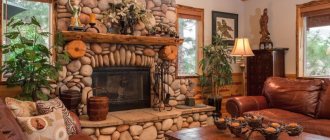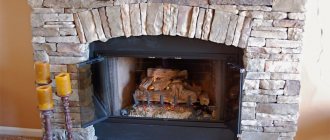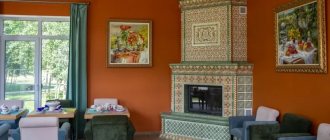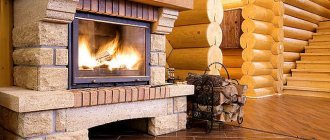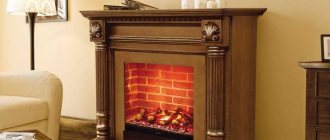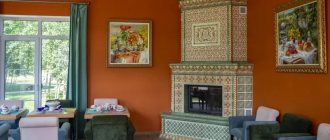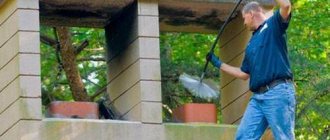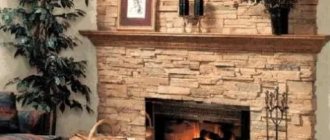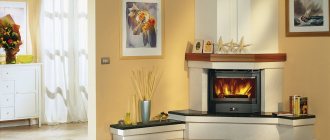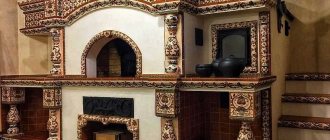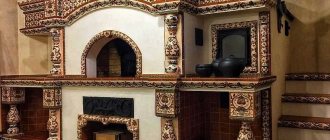Primitive man was tired of keeping the fire burning all night long. By covering the hole with stone, a Stone Age inhabitant created the world's first hearth. In the 21st century, a fireplace has become an indicator of the prestige, thoroughness, and seriousness of the owner of the house. A fashionable item in the interior is not installed to heat the estate. Decorating the fireplace with natural stone adds a romantic charm to the family nest. Let's figure out what lies behind the beauty of minerals. Why is it important to choose the “right” fireplace? Let's look at the advantages and disadvantages of each model.
Features of natural stone
Mineral aggregates are traditionally used as natural stones for finishing fireplaces. The most common natural facing materials are marble, sandstone, and granite. The main advantages of natural stone:
- environmental Safety;
- strength;
- durability;
- high quality;
- variety of textures;
- easy care of a smooth surface.
The surface of natural stone may contain cavities, veins and inclusions. These points are not defects, but features of a natural mineral. Advanced techniques used for stoves and fireplaces make it possible to create portals of any complexity.
Uneven grinding
Carving, polishing, grinding require time and skill. The heterogeneity of the stone is the main reason for the appearance of roughness in some areas. Even the color shade can change on one slab. Designers working on cladding can spend months selecting the right pattern. For example, marble takes polish well, and when polished, it reveals its structure more intensely.
Caverns
Under the influence of natural processes, voids are formed in rock aggregates. irregular or oval in shape. Cavities vary in size (from 1 mm to 100 mm) and shape (irregular, oval, etc.).
Microcracks
Products made from wild stone, despite the high quality of processing, may have small cavities, veins, etc. on the surface. Geologists call microcracks not a defect, but a sign of wisdom and kindness. Microscopic depressions indicate the metamorphic origin of the mineral. The stone is calm and energy flows are balanced. The crack will never grow, because... Before cutting into slabs, the minerals are treated with special resins in a vacuum chamber.
Calcite veins
Fluid inclusions are formed in wild stone as a result of the replacement of one mineral by another. At the same time, the external forms of the source material are preserved. Calcite is included in marble and is the main component of limestone. Pseudomorphosis fills voids and forms veins that look like cracks without depressions. Most often, the mineral aggregate is found in brown and beige marble.
Fossilized shells
Cephalopods inhabited our planet many millions of years ago and became extinct along with dinosaurs. Over time, the fossils were exposed to mineral solutions and settled in rocks. Fragments of ammonite, brachiopod and other species can be found in fireplace mantels. In cross-section, spiral-shaped fossilized shells create picturesque patterns reminiscent of a starry galaxy. Natural inclusions in stones are perceived in many cultures as a symbol of longevity, family wealth, and prosperity.
Fireplace plaster
Plaster is one of the simple and practical options for decorating a brick fireplace. A few years ago, plastered surfaces were whitewashed or painted. Today it is possible to apply a decorative layer with different textures on top of ordinary plaster.
Finishing a fireplace with plaster can be fragmentary
Types of plaster for fireplaces
Finishing a fireplace with plaster is popular for the reason that any design can be developed. The second plus is that if everything is done correctly, you can achieve a smooth surface, the finish is beautiful and durable. For plastering fireplaces, the same compositions are used as for brick stoves. Although the heating temperatures of the surfaces differ, the plaster mixtures are made the same. There are two options: make the plaster composition yourself or buy a ready-made one. If you don’t have experience working with clay and determining its fat content, it’s better to buy one. Store-bought plasters for fireplaces and stoves contain additives and additives that make the surface more durable and cracks are less likely to appear in it.
Mixtures for fireplace plaster
As a rule, each manufacturer has two formulations with different properties. The first is basic, for rough finishing. It can be applied in a fairly thick layer - up to 10 mm. After drying, the second layer is laid - the finishing layer. It contains more finely ground substances, is applied in a thin layer - usually up to 3 mm, and the surface is smooth. Such a surface can already be painted if it has been plastered smoothly) or decorative plaster can be applied.
If you want to finish the fireplace at a minimal cost, you can make plaster compositions from clay, sand and lime yourself. But, let us repeat once again, without experience working with clay, it is difficult to ensure that homemade plaster does not crack. Compositions for plastering a fireplace for making them yourself are different, here are a few proven ones:
- Clay-lime: 1 part clay and slaked lime + 2 parts sand;
- based on slaked lime - 2 parts lime, one part gypsum and sand.
To make the fireplace plaster solution more durable, reinforcing fibers are added to it. Previously, it was finely chopped straw, later - asbestos fibers, and today glass or fiber fiber is mainly added. The fractional part of this additive is small - 0.1-0.2 parts. It is added to the dry components (cement and sand), and everything is mixed. The dry mixture is added to the clay and/or lime dough, mixed thoroughly again, and water is added if necessary.
It is better to take lime already slaked, in the form of lime paste. If you extinguish it at home, unreacted particles always remain, which are then extinguished during the operation of the fireplace, destroying the plastered surface. Regarding sand, its quantity is precisely selected depending on the fat content of the clay. The solution must be sufficiently plastic. The fat content of the solution is checked using a piece of wood. Dip it into the solution and remove it. If an even layer 2-3 mm thick remains on the surface, the solution is normal. If the layer is thick and lumpy, you need to add sand; if the stick is almost clean, add clay.
Normal fat solution
The clay is pre-soaked (2 days or until all the lumps are limp), then rubbed through a metal sieve with a mesh of 2 cm. The ground clay dough is once again pressed through the mesh, but with a fine mesh of 0.5-0.7 mm.
You need quarry sand, it must be clean and dry. It is also sifted before use.
For those who don’t want to deal with homemade compounds, here are several companies that produce plaster for fireplaces and stoves. The following compositions performed normally:
- Plitonite super fireplace refractory;
- Petromix KU;
- heat-resistant Terracotta plaster;
- Bossnab;
- RS Parade;
- rtner;
- Kiln plaster HEFNERPUTZ.
The list includes both domestic and European manufacturers. This is not to say that Russian compounds are worse, but working with imported ones is easier.
Features of plastering stoves and fireplaces
The technique of applying the solution itself is no different: a certain layer is applied (sprayed) with a spatula or a special ladle, then leveled (possibly using beacons). The main points are to prepare the fireplace surface for plastering:
- First, all old finishing, if any, is removed from the walls - paint, lime, remains of plaster, mortar, etc. Only clean brick should remain.
- For better adhesion of the plaster mortar to the surface, the seams are deepened by about 1-1.5 cm. Take jointing, a chisel or a screwdriver and scrape out the mortar in the seams.
- All existing cracks are sealed with a repair compound or heat-resistant sealant (which can withstand heating up to 800°C).
- When everything is prepared, take a brush with long bristles and clean the surface well. It must be clean.
- The following are the options: If the surface of the fireplace is relatively flat (the difference is less than 5 mm), you can wet the walls and begin to apply plaster.
- If, due to the curvature of the surface, the layer will have to be made more than 5 mm, reinforcement is necessary. A metal mesh with a fine mesh is stuffed onto the walls of the fireplace. It is secured with nails, which are driven into the seams (the seams can be left unstitched, or stitched, but not so deeply). To ensure that the caps hold the mesh, metal washers larger than the mesh size are put on. Plaster is applied over this stack. In this case, you can be sure that the plaster will not fall off.
Fireplace after plastering
Before you start plastering the fireplace, carefully read the instructions on the package. It usually describes under what conditions and how the plaster should be applied. But experts advise lighting the fireplace, heating the walls to 60°C, then moistening the surface and starting to plaster. The walls are heated so that the brick takes on its “working” dimensions. In this case, there is less chance that the plaster will tear when heated. Wetting with water is necessary to ensure that the solution is not too dry: brick is hygroscopic. If it is dry, it quickly draws water out of the plaster mortar and it becomes too dry and does not harden to its normal state. The result is cracks on the surface.
A few more points regarding drying. When plastering a fireplace, at least two layers are applied. The second can be applied only after the first has dried completely. To speed up drying, you can create a draft, but you cannot light the fireplace. The same applies to the second - finishing - layer.
For the technology of plastering stoves and fireplaces, see the following video.
Advantages of finishing fireplaces with stone
A stove in a home is an integral part of the material culture of mankind. Kaminos (translated from Latin as “hearth”) as a complex functional object has been known since the ancient period (1st century BC). Cladding the fireplace with natural stone creates a cozy atmosphere in the house, adds luxury and sophistication to the interior space. The design, thought out over centuries, is, in addition to beauty, characterized by undeniable advantages:
- Natural stone can withstand any temperature changes, high humidity, and thermal stress.
- Environmental safety of natural cladding.
- Strong, durable material resists mechanical stress and cannot be deformed.
- Heat storage stoves not only decorate, but also heat the house.
- The ability to choose from a variety of styles and finishing options to suit your favorite building.
- The ability of minerals to take any shape during processing, taking into account the texture of the product.
The best stone fireplace portals are equated to works of art and are exhibited in museums around the world.
Heat capacity
Natural stones radiate heat longer than other materials. Heat storage stoves create comfort in the home and do not require constant supply of raw wood. A warm stone spreads energy through the flow of air flowing over the heated surface. The soft warmth of heat-resistant natural stone (granite, marble, basalt) does not spread dust or cause a feeling of draft.
Variety of shapes
The first fireplaces, which became monuments of world architectural art, appeared in the Middle Ages. In France, the hearth of the Mont Saint-Michel Abbey is kept. Pilgrim knights gathered around a huge structure made of cut stone. In the firebox was the carcass of a bull, which was roasted whole for the evening meal. From the mid-13th century, monastic asceticism was replaced by the desire to live in beauty. Thanks to the architects, the fireplace room became no less important than the royal living room. During the Renaissance, granite and marble fireplaces were decorated with Florentine mosaics, columns and pilasters. In the 15th century, to protect the structure from intense heating, the wall was decorated with cast iron slabs. In the 19th century they used elegant grates. At the beginning of the 20th century. A tiled fireplace panel by M.A. was exhibited in Paris. Vrubel, sparkling with all colors. The cladding, made in the majolica style (fired clay with painted glaze), gave the ceramics the appearance of a precious stone. A new name has appeared - “Russian Fireplace”. The emergence of many options for finishing a fireplace allows craftsmen to produce a functional piece of furniture of any design and color scheme.
Durability
650 million years ago, the Solar System, traveling around the center of the Galaxy, crossed the iron-dust nebula of the Milky Way. A huge amount of cosmic dust fell on Earth. During the Precambrian period, siliceous sediments accumulated in reservoirs. Under the influence of the internal forces of the planet, the fossils were compressed and turned into minerals. Humanity has received a durable building material. With proper installation and the necessary care, a fireplace lined with stone will last a hundred years.
Completeness of design
Natural stone with expressive veins, unusual inclusions, and rich color always looks impressive. Facing materials preserve the natural structure and beauty of the mineral. Sand rocks in massive fireplaces convey the mood of the ancient East. Marble and granite emphasize the well-being of the owner of the house. Modern technologies make it possible to cut out shapes of any complexity and create any color shade. All elements will complete the design, corresponding to the stylistic design of the home.
Increasing home value
Using natural stone to surround a fireplace will help sell your home profitably if necessary. The beauty of a massive structure, the price of material and work will significantly affect the final cost of the home. Elegant marble and monumental granite will only emphasize the luxury of your home.
Cost of cutting, grinding and drilling large-format porcelain tiles
| Name | Unit change | Price in rub. |
| Straight-line cutting of large format tiles | p/m | 450 |
| Sanding the end of large format tiles | p/m | 750 |
| Drilling holes 50 - 100 mm | PC | 1400 |
| Square holes | PC | 1900 |
| Installation of large format tiles at 45 degrees | p/m | 1300 |
Order
Advantages of natural stones
Scientists consider beauty and energy to be the main advantages of natural minerals, which cannot be reproduced artificially. Strength and resistance to environmental influences are important characteristics of durable minerals. Cladding stone for a fireplace has a number of advantages compared to artificial materials:
- does not harm human health;
- does not contain polyester resins or other harmful substances;
- a natural mineral is inert, i.e. does not react with other minerals;
- a heat-resistant slab can withstand temperatures of hundreds of degrees (for example, marble begins to collapse at temperatures above 910°C);
- the design and rich color scheme cannot be repeated;
- fireplaces made of natural stones do not age and remain always fashionable interior items.
Natural minerals are a high-quality material, elitism, and a historical image.
Questions and answers
Which stones will last the longest?
Granite and marble have the highest durability.
What artificial stones are best to choose for cladding?
You should focus on your budget and the desired type of fireplace. The only rule is that when decorating a fireplace, it is better to avoid stones with a polymer filler.
Which stone will be the most durable?
Granite has the greatest strength.
What material is the safest to line a fireplace with?
Natural rock stones are safe for humans and do not release harmful compounds into the environment when heated.
Is it necessary to use heat-resistant stones for facing a fireplace?
Yes, fireplace stones must be heat-resistant. The only exception is plasma fireplaces.
Disadvantages of natural stones
An objective disadvantage is considered to be a lot of weight. In recent decades, the myth about the radioactive properties of rocks has spread. Scientists have conducted a number of studies and found that natural stones do not pose any danger to human health. Strict radiation requirements protect the consumer. All mined stone is tested, and safety is confirmed by a certificate. Disadvantages include high cost, difficulty in installing stone cladding, and labor-intensive work.
Price list for laying porcelain tiles
| Name | Unit change | Price in rub. |
| Laying porcelain tiles on the floor in a straight line | sq. m | 1100 |
| Laying porcelain tiles on the floor diagonally | sq. m | 1200 |
| Laying porcelain tiles on the floor in a herringbone pattern | sq. m | 1300 |
| Laying porcelain tiles on the floor in staggered steps | sq. m | 1100 |
| Laying porcelain tiles on walls in a straight line | sq. m | 1100 |
| Laying porcelain tiles on walls in a herringbone pattern | sq. m | 1200 |
| Laying porcelain tiles on walls in a staggered manner | sq. m | 1100 |
| Seamless laying of porcelain tiles | sq. m | 1400 |
| Laying large-format porcelain tiles | sq. m | 1500 |
| Finishing the toilet with porcelain stoneware | sq. m | 1300 |
| Finishing the bathroom with porcelain stoneware | sq. m | 1300 |
| Finishing slopes with porcelain stoneware | p/m | 800 |
| Laying porcelain tiles on an apron | sq. m | 1500 |
| Installing porcelain tiles on a kitchen island | sq. m | 1400 |
| Facade finishing with porcelain stoneware | sq. m | 1200 |
| Cladding the plinth with porcelain stoneware | sq. m | 1300 |
| Finishing the stairs with porcelain stoneware | sq. m | 800 |
| Installation of porcelain stoneware plinths | p/m | 400 |
Order
What you should pay attention to when choosing a stone
Today, fireplaces are designed for utilitarian use rather than art. Physical and mechanical properties, pattern and texture of the rock, features of the purpose of the premises - all this influences the choice of natural stone. What you should pay attention to:
- Plan a budget (includes the cost of materials and the work of professionals).
- Review the durability and maintenance requirements of natural mineral.
- Select a style or “cut” of the stone.
- When purchasing facing stone for stoves and fireplaces, consider the heat-resistant characteristics.
- View the quality certificate guaranteeing compliance with the parameters.
- On the packaging, check the brand logo and manufacturer's coordinates.
- If you are looking for the most durable mineral, choose granite.
- Check the quality of the material, which should not contain defects, deep cracks, chips, or other signs of defects.
- Natural rock stones must have a uniform surface.
Check cuts that may have been damaged during processing of the mineral.
What type should the fireplace have?
The variety of fireplaces is classified according to design and style. Particular attention is paid to fireplace portals. They come in two types and are named after their external association with the letters “P” and “D”.
- The most common type is U-shaped, which is found among fireplaces of all styles.
- D-shaped portals are characteristic of “Country”, “Modern”, and sometimes “Classical” styles.
Like architectural structures or works of fine art, fireplaces are classified by style. A separate group includes natural stones that are not used for artistic cladding. For example, basalt slabs are great for insulation and heat retention.
The style variety of fireplaces is presented in the table.
| Style | Peculiarities |
| Romantic | For cladding the fireplace, untreated stones or exposed bricks are used. |
| Classical | Suitable for those who want to make a living room similar to Queen Victoria's study Royal style means fireplaces with harmonious proportions, straight lines, simple decor |
| Country | Opens up wide possibilities for finishing the portal in a folk style |
| Rococo | Aristocracy style Low fireplaces are covered with marble tiles. Massive clocks and candelabra are placed on the mantelpieces. Paintings in luxurious frames are hung nearby. |
| Empire style | Since the second half of the 18th century, the fireplaces bear the stamp of theatricality, borrowed from ancient Roman examples. Columns, pilasters, griffins, sphinxes, and lion paws appear |
| Modern | Style design of the early 20th century Lush decor is replaced by the color of stone Elongated design similar to a pencil case |
| Russian style | The ancient custom of decorating fireplaces with ceramic tiles is used. Tiles of semicircular, angular, relief shapes with paintings are mounted on special heat-resistant boxes |
| Modern, urban | There are no expensive installations in the decoration. The fireplace is perceived as a source of beauty of living fire in a natural frame. |
Designer fantasies embody any type of natural stone. But marble fireplace portals have become a symbol of sophistication and luxury. In addition to the beauty and variety of colors, marble concentrates great bioenergy and draws out many diseases.
DIY work
Building a fireplace is a difficult task. Some jobs can be done on your own, while others will require the help of professionals. The main difficulties are caused by arched ceilings. The person himself decides what material will be used for cladding. All elements and mixtures must be of high quality. The simplest option is to use ordinary red brick. Planned budget Installation of a complex functional object requires serious preparation. The first step is to create a construction budget. Calculations depend on the type of fireplace. For example, the standard one will require lower costs. Corner, island or double-sided increases the budget several times. The plan includes:
- cost of cladding material;
- firebox type:
- carrying out installation work;
- building materials (clay, sand, masonry mortar, etc.);
- stove maker's tool kit.
Draw up a scenario in numbers, taking into account as many factors and details as possible.
Durability
Stoves and hearths have always played a leading role in the home. A fireplace is not a dress or a suit. Clothes are chosen based on anything. When purchasing a stone, the requirements for durability and maintenance nuances are taken into account. Basalt slabs will never crack, marble or granite will last for decades, low-quality brick will crumble at any minute.
Cut
The processing of a stone, which gives the desired shape (symmetrical, multifaceted, oval, etc.), is called cutting. When choosing the type of polishing, take into account the style of the fireplace, the features of the mineral that need to be shown from the best side. In their natural state, natural stones look unattractive. After cutting (modern, classic or rustic), the heat-resistant material acquires decorativeness and elegance.
Connection technique
Recessed (dry), standard, wide seam are the main types of fireplace stone joints. Homogeneous joints are obtained with the correct use of building materials. The quality of clay is determined in a simple way. Flagella rollers are made from plastic material (diameter 2 cm, length 25 cm). If the clay is not flexible enough, sand is soaked from it. Clay of medium plasticity is suitable for fireplace masonry. Cement mortars are prepared in quantities that can be used within 45 minutes. Colorful fillers enhance the overall look of the portal design.
Master class on laying tiles
Tiling a fireplace with your own hands is not that difficult. The entire finishing process will take 5-8 hours. The builder's high level of skill will significantly speed up the procedure. The grouting is done the next day, so you can get a beautiful, stylish interior element in just two days.
The finishing process is divided into three stages:
- Surface preparation;
- Cladding works;
- Finishing.
The process is completed by decorating the mantelpiece and part of the chimney if you plan to use wall decorations.
Preparatory work
Before tiling the fireplace, its surface must first be prepared. If the old layer of finishing has been removed from it, then the portal is cleaned of any remaining adhesive and leveled. Then the surface is degreased and small particles of dust are removed, which can subsequently affect the quality of fixation of the finishing material. The treatment is completed by applying a layer of mastic, which seals microcracks.
Tools and materials
For work you will need the following materials:
- Tile;
- Corner elements;
- Heat-resistant grout for joints and glue;
- Identical pieces of drywall to create even seams between elements.
The standard set of tools includes:
- Level and plumb;
- Latex gloves;
- Construction pistol;
- Grinder with a disc for cutting tiles;
- Comb spatula;
- Rubber hammer;
- Unnecessary container (bucket, bowl);
- Drill and attachment for mixing dry mixtures.
The list of materials is sometimes supplemented with special means for surface treatment after laying the tiles. For example, some use dirt-repellent agents.
Technology for laying tiles on the walls of the fireplace and exhaust pipe
The fireplace should be covered only after surface preparation has been completed. Start from the corners. They are fixed after measurements are taken. They will serve as a guide that will ensure that even rows of tiles are laid without distortions. Heat-resistant glue is mixed in a container. Then it is applied with a comb spatula to the back side of the tile. For better adhesion, the surface of the fireplace is also covered with glue in a similar way. Then a tile is applied to it and, after correcting the position, pressed with force. Finish fastening by tapping with a rubber hammer. To maintain a gap of the same width between the seams, pre-prepared pieces of drywall are inserted into them. It can be removed only after 12 hours from the moment the decor is fixed. If necessary, the tiles are cut with a grinder into fragments of the required size. A day after installation, you can start grouting the joints. The composition has a base white color, which is adjusted using special dyes. The grout is mixed with pigment according to the instructions, and then filled into a construction gun. Its nozzle is inserted into the groove of the seam and the mixture is carefully squeezed out, moving along the gap. The grout should be level with the tile, but not protruding above it. If some of the composition gets on a clean surface, there is no need to immediately try to wipe it off. The grout is removed after it has hardened using a screwdriver or knife. After 1.5-2 hours, the composition will begin to thicken and acquire the consistency of a dense paste. Now we begin to unstitch the seams, which is carried out using a regular flat-head screwdriver.
If the elements are secured using glue without mastic, then the “wrong” side of the finishing material is slightly moistened with water.
The best options for cladding
Fireplaces made of natural stone look organic. The chosen style is reminiscent of the era in which examples of high artistic value were created. Ural gems are recognized as the best finishing materials in the world. Fireplaces lined with malachite and rhodonite are considered unique products, separated into a separate group. The decoration of fireplaces made from natural minerals is distinguished by a variety of color shades, combining picturesque designs, dark and light spots, and sinuous lines. The dense rock is well polished and is not subject to mechanical stress. The white, cream, golden sand color of the cladding as a decorative element lasts for years.
Granite
Natural stone is the best finishing material. To finish a fireplace with granite, slabs with a thickness of 20-30 mm are used. Strength, high resistance to temperature changes, the beauty of the stone, and a variety of colors are the main advantages of the coarse-grained mineral. Designers recommend using porcelain stoneware, an artificial resemblance to natural stone, to decorate the fireplace.
Limestone
A less expensive version of natural stone is used for electric fireplaces. Limestone is a porous sedimentary rock composed of calcite crystals of varying sizes. Depending on the processing method, the design is made in country style or elegant urban style.
Marble
The main advantage of marble portals in comparison with other natural stones is their rich range of colors. In modern interiors, the mineral is used in different styles: from classic to high-tech and modern. The appearance of marble splendor is complemented by bronze casting and decorative elements. Wall mirrors look good, and figurines and candlesticks on the mantelpiece.
We recommend reading about marble in detail: Marble: properties, colors, use in interiors
Quartzite
A long-lasting, durable mineral begins to deteriorate after 150–300 years. Spectacular and expressive varieties of quartzite are used as an ornamental stone for facing fireplaces. Due to its high decorative qualities and color palette, quartzite is classified as a semi-precious mineral of the first order (along with malachite, jasper, lapis lazuli, and agate).
Slate
Golden, purple, brown varieties of slate have a layered structure with parallel accretion. Individual plates of varying thickness or solid blocks are a convenient building material for cladding. Fireplaces always look stylish in the interior and create the atmosphere of a country house. In terms of quality characteristics, slate is comparable to granite.
Multicolor slate fireplace
Travertine
The fine-grained, porous mineral is formed by the precipitation of calcium carbonate in carbonated water. In underground caves it is found in the form of stalactites and stalagmites. Tiled travertine always has a porous surface and is used as a lining for fireplaces. A banded light yellow mineral is a versatile stone. The treatment can give your fireplace both an antique and a modern look.
Soapstone chlorite
Opaque natural stone with a matte silky sheen maximizes thermal energy absorption, withstanding temperatures up to 1600 °C. The mineral is easily processed and is not affected even by strong acids. These qualities make soapstone an excellent material for cladding fireplaces. Depending on the impurities, the color changes from white to dark cherry. Sometimes a very smooth colored stone is passed off as jade.
Sandstone
A versatile mineral with a wide variety of shades, it can be easily processed. For a fireplace, you can choose sandstone of any thickness and configuration. Ornamental stone is an ideal option for interior decoration. Layered tiles for cladding are attractive due to their texture, shades of color, beauty and durability.
Video “10 ideas for beautiful fireplaces trimmed with natural stone”
Varieties and classification
Finishing a fireplace with porcelain stoneware can be done on your own. When purchasing this coating, first of all you need to familiarize yourself with its varieties. Textures:
- Matte. It is distinguished by its affordable price. The material undergoes mandatory firing, after which it is not further processed. Has high quality;
- Polished. After firing, the surface is cut off and polished. As a result, a clear pattern and shine are formed. When cut, subsequent layers form small micropores into which dirt easily gets clogged. Maintenance of this coating must be carried out regularly and efficiently;
- Semi-polished. The partial layer is selectively removed, and the surface acquires a combined structure, with alternating shine-smoothness and dullness-roughness. Easy to care for and has a spectacular appearance;
- Waxed. It has a similar polished texture. Before firing, various crystals are applied to the surface, due to which the structure and surface become shiny;
- Glazed. Enameled compounds are used as the main layer, after which they are fired. The coating is of high quality and durable, does not scratch;
- Rectified. Manufacturing takes place on special equipment that cuts the sidewalls of porcelain stoneware to achieve the required size and shape.
Important: porcelain stoneware is a universal material that can be used in both classic, country and retro styles, as well as in a modern direction (More information about fireplaces with modern finishes can be found in the article: Modern fireplaces: masonry, design, manufacturing and features).
Alternative fireplace finishes
In addition to traditional minerals, wood, fragile tiles, durable steel, and artificial stones of all varieties are used to decorate fireplaces. The choice of portal depends on the location of the structure and the taste of the owner of the house.
Concrete
Cladding with natural material looks very stylish, but is very expensive. Framing the fireplace with special concrete is the best budget option. Artificial building stone gives the interior a modern look and retains heat well. Various pigments, marble or granite chips can be added to the elastic material.
Stone veneer
The flexible building material is made from shale minerals. The thinnest layer of natural stone is fixed with a special resin onto a fiberglass base. The boards, resistant to temperature and moisture, are durable and extremely easy to maintain. Each sheet of stone veneer has a unique pattern and unique texture.
Brick
The interior of the fireplace is lined with refractory bricks that can withstand temperatures of 900° C. To cover the portal of a brick fireplace, different types of durable building materials are used (clinker, facade, hand-made “aged”). A large selection of shapes, a wide range of colors, and the ability to choose the desired texture allow you to make a brick fireplace beautiful and durable.
Tile
Torn stone, ceramic, decorative, “brick-like”, majolica - any tile from a thousand types will become a decoration for the hearth. Large-format and strict porcelain stoneware is considered the best material for cladding large fireplaces. Monolithic structure, wide choice of decor (marble, granite, etc.) will satisfy the taste of even a professional designer.
Tree
For exotic lovers, portals made from various types of wood are suitable. The main condition for safety is a properly laid out fireplace. The cladding can be combined with other finishing materials. The most popular types of wood: oak, cedar, cherry, walnut. Wooden elements are used when decorating a portal in a natural rustic or country style. For classic fireplaces, valuable tropical species such as mahogany are chosen.
Steel
A popular fireplace surround material gives the interior a modern, industrial look. The steel structure is characterized by high heat transfer, small dimensions, and ease of maintenance. Sheet metal for finishing portals is made in classic square, oval, trapezoidal shapes.
Fake diamond
The facing material is not inferior in beauty to natural mineral. Fireplaces made of artificial stone look luxurious and naturalistic. The structure of the outer covering imitates the natural texture and rich color palette of natural stone. For example, the decoration made from artificial eagle cannot be distinguished from natural rhodonite. The portal shines like a gem, combining shades of cherry pink with dark spots and sinuous lines. According to legend, small stones were found in nests with chicks of eagles.
It is believed that in a house where a fireplace is installed, healthy and proud children will grow up.
Artificial materials
Artificial stone is used quite often for facing fireplaces. The advantages of such a coating include the most accurate visual imitation of natural stones, not only preserving the color, but also the structure. At the same time, the products are lightweight and versatile. They withstand high temperatures well and can be used for finishing any surface.
The fireplace portal, lined with artificial stone, does not have a significant impact on the floors of the house. At the same time, artificial analogues are easy to process with your own hands and without the use of professional tools.
Today, in the assortment of stores, you can find artificial stone with a certain texture, imitation, and color. The product is easy to cut and takes on the desired shape.
But artificial minerals can also have their drawbacks. Before purchasing, you need to make sure that you are buying products from a trusted manufacturer, for which the seller has all the necessary quality certificates.
Many products are of insufficient quality and are not intended for cladding heating units. When heated, they begin to release harmful and health-hazardous decomposition products into the space.
High-quality material should not have various chips, deformations and other damage on its surface, which could lead to a violation of the tightness and safety when lighting heating equipment.
Artificial analogues also partially contain environmentally friendly components. These include stone chips, which make the product strong, durable, heat-resistant and safe to use.
Stone development can be carried out using one of the two technologies presented below:
- Acrylic stones are based on marble chips, which can be about 70-85 percent of the total composition. In order to give the final material the necessary strength, acrylic resin is added to its composition, from which the name of the stone originated. The composition may also contain various additives and dyes that give the product a certain color or pattern. This, in turn, allows you to imitate almost any stone, even precious. The advantages of this variety include durability and ease of maintenance. To remove dirt, you do not need to use chemicals, just a sponge or cloth soaked in water is enough;
- The most convenient and simplest is the installation of modern flexible stone. Due to innovations and developments, this material is produced in sheets whose dimensions are 96x48 centimeters, with a sheet thickness of 1-5 millimeters. The sheet is based on marble chips, due to which the surface of the product is slightly rough. Externally, this material resembles linoleum. The advantages include low weight, no seams that need to be rubbed, good tolerance to high temperatures, environmental friendliness and the absence of harmful emissions. Using this material, you can decorate a fireplace and any interior item with your own hands and in the shortest possible period of time. Even simple stationery scissors are suitable for cutting.
Gypsum stone is the simplest and most cost-effective option for cladding a fireplace portal. You can either buy it or make it yourself from a special solution and pre-purchased or made blank molds. The advantages of the material include environmental friendliness, durability and low weight.
Tips for purchasing material
Almost any material available on the modern market can be used to decorate a fireplace. When going to the store, you should consider the following factors:
- Availability of a certificate confirming compliance with sanitary standards.
- Reputation of the manufacturer, length of work in the chosen field.
- Branded, undamaged packaging with the company logo.
- Date of production and packaging of the material.
- The cost of the selected finish. Too low a price may indicate questionable quality of the material. Unreasonably high – indicates high markup from the manufacturer.
If the work is carried out by a hired master, pay attention to his reputation. A bad specialist can ruin even the most beautiful fireplace cladding material.
How to work with porcelain tiles: installation
The material is laid using a special glue. If it is not there, then a special metal frame should be made to ensure strength. They do it like this:
- Along the perimeter of the fireplace there is a frame made of metal profiles. The installation pitch must correspond to the dimensions of the porcelain stoneware slabs. The profiles are connected to each other using self-tapping screws, and the entire structure is attached to the fireplace with anchor bolts.
- Porcelain tiles are fixed to the frame using special brackets.
- The space created between the slabs and the body of the fireplace is filled with a clay mixture, to which crushed stone and sand are added for strength.
- The joints of the slabs are coated with a mixture of sand, clay and colored pigment.
- When the cladding is completed, the fireplace should be heated for several days in a row. The high temperature will bake the clay. This will improve the thermal performance of the fireplace.
This finishing method is perfect for a portal laid out by an inexperienced craftsman. Installing the cladding on the frame allows you to hide all the defects, and the fireplace will not have to be plastered for a long time.
Preparing for work: useful tips
It doesn’t matter whether you want to clad the fireplace with artificial stone or natural stone, when performing the work you must follow certain rules:
- All work should be carried out only in a warm room, not lower than +5 °C.
- The stone should only be laid on a suitable base, treated in a special way. Chipboard, cement screed, wood and other materials can be used as a substrate. Preparation methods are different for each material.
- When sawing workpieces, do not use blades with large teeth. Such files can ruin the finishing material. A hacksaw with a fine tooth is best.
- It is better to cover the fireplace with decorative stone from top to bottom. In this case, the previously laid elements will remain clean. If the material is heavy or the master does not have too much experience, you can start from the bottom. In this case, you need to work very carefully.
- Each type of facing material has its own adhesive composition. It is better not to ignore the manufacturer’s recommendations and use the fastening solution that will achieve the best result.
